-
It
gives background, history of lipan kaam, materials and process and design of
lipan kaam. Lots of pictures of mud homes in Kutch.
If
you travel to Kutch, you will come across the odd bhunga (mud house) with walls
beautifully-decorated in mostly circular mirror-work. This is Lipan Kaam.
If
you travel through Kutch (and for the love of art and natural untamed beauty
you must), you will most definitely be tempted to stop time and again at
different villages and towns to admire the arts and crafts of this part of
Gujarat.
As you make your way through the vast stretches of the Indian side of the world’s greatest salt desert (the Great Rann of Kutch), you will come across the odd bhunga (mud house) with walls beautifully-decorated in mostly circular mirror-work. This is Lipan
Kaam. Bhungas did not get destroyed during the 2001 Kutch Earthquake.
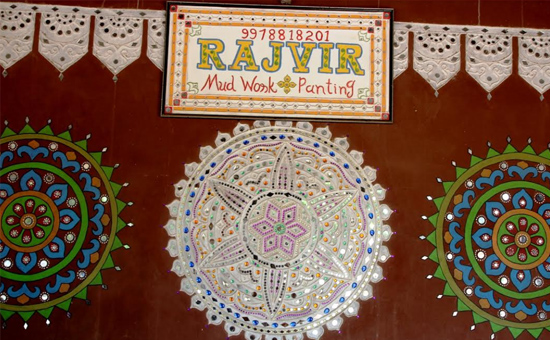 Lipan Kaam, village about 45 kms from Bhuj.
Lipan Kaam, village about 45 kms from Bhuj.
Background
Lippan or mud-washing, using materials locally available in the region like mixture of clay and camel dung. Mud houses are cold in summer and warm in winter. Air gaps in mud helps to remain cold in summers and warm in winter.
Saw similar style homes in a village near Jodhpur too. Prajapati told me that tin sheet roof and concrete structures get hot in the summers whilst traditional homes were cool then. The reverse works in the winters.
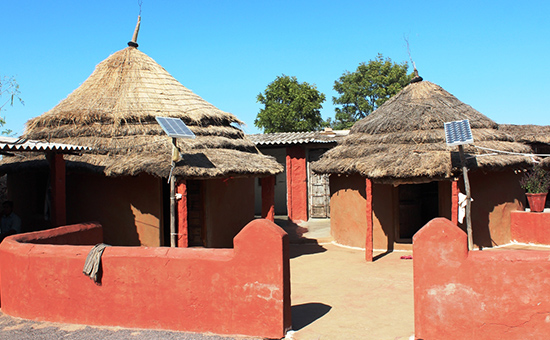 House in village near Jodhpur.
House in village near Jodhpur.
Though
the work is limited mainly to the interior walls, it can be found on the outer
walls as well. These scintillating murals bring life, gaiety, and beauty to
generally harsh life of people of Kutch.
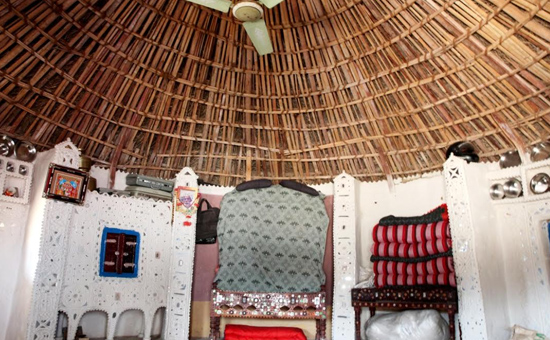 Kutch-Interior of a village home, see mirror work on left side.
Kutch-Interior of a village home, see mirror work on left side.
Mud
and Mirror Work is mainly done by the women of the Rabari community.
The women are so experienced in this art form that they usually don’t draw or trace a pattern before beginning work. Rabari is the pastoral community of Kutch, living in the outskirts of its villages. They dwell in a few clusters of communal or family houses known as Bhungas which are designed and built to take care of their practical needs in the harsh climate of Kutch.
This
art form has a hoary past as no records are available to trace its origin.
Various communities in Kutch do mud-washing in their own distinct style.
Artisans
of the Muslim community practicing this art form stick to graphic and
eye-catching geometric patterns of lippan kaam, as depicting the human or
animal form is considered deeply un-Islamic.
Mud
mirror work gathered attention of the modern world for its intricate pattern
and aesthetic perfection and has made a full transition from its unknown modest
stature to the mainstream art world, decorating the walls of urban homes.
History of Lipan Kaam
Mud
and mirror work is known as Lipan Kaam. It is a traditional mural craft of
Kutch. It is also called as Chittar Kaam. The origins of Lipan Kaam are
unknown.
Various
communities in Kutch do mud-relief work and have their own distinct style of
Lipan Kaam. This makes it even harder to trace the roots of Lipan Kaam.
Literal
Definition:
In
Gujarati language, Lipan = mud-washing and Kaam = work
Production
Cluster
Lipan
is from Kutch district: Ludiya, Gorewali, Banni, Baniari.
Kutch, the home of Lipan Kaam
Most
communities in Kutch live in circular mud houses known as Bhungas. They
have thatched roofs. These dwellings have evolved over the years to take on the
harsh climatic conditions of Kutch. Generally speaking, Bhungas are
made of clay alone or bamboo chips plastered with lipan, a mixture of clay and
dung. The roofs are wood-based and thatched.
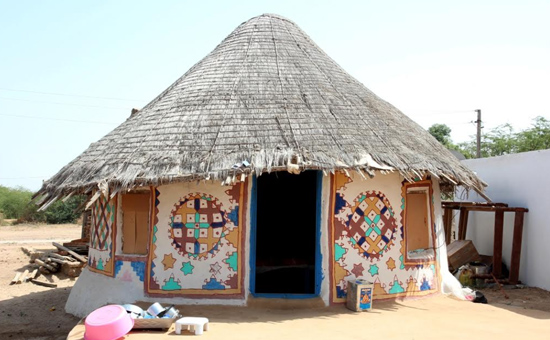 Typical circular
mud house.
Typical circular
mud house.
Areas of the bhunga where you’ll typically find Lipan Kaam
Kotholo -
Large storage granaries
Sanjiro -
Large storage for valuables and clothes
Kothi -
Cylindrical grains storage
Dhadablo -
Seat for babies
Utroni -
Clay stand
Chula -
Portable hearth
Paniyara -
Clay platforms
Pedlo -
Platforms on which the storage bins are placed
Decoration
on Walls, Alcoves, Plinths, Shelves, Windows
Lipan Kaam – the materials and the process
The
dung used is that of a camel or wild ass and acts as a binding agent as it is
rich in fibres. The clay used is mud which has been passed through a sieve to
obtain fine particles that mix more easily.
Equal
proportion of dung and clay are mixed and kneaded to form the dough used for
lipan kaam. (In conversations with those who practice lipan kaam, some have
mentioned the use of husk of Bajri i.e. millet as an alternative to
the dung. While the dung attracts termites, the husk does not.)
Watch (7 minute video) how an
old lady makes lipan come to life and talks about life in the land of lipan
kaam. This is seven or so minutes of beautifully handmade in India.
Small
portions of the dough are taken and shaped into cylinders of varying thickness
by rolling between the palms or on the floor. This is then pasted on to the
moist surface i.e. the wall or wooden panel on which the decorative artwork is
to be done. Each artwork usually starts by using the dough to first create lines
that define the boundary of the artwork. Motifs are then created in bas-relief
(sculpture in which the figures project slightly from the background) mostly
freehand by memory by using palms and fingers pinching and shaping the mud
mixture.
The
motifs are inspired from the rich and famous embroidery patterns and once the
walls are done they look stunning with mirrors embedded in the mud work, much
like the embroideries itself. The mirrors used are called aabhla and come in various shapes -
round, diamond & triangular.
After
the clay dries off in about 4-5 days, a layer of white clay is painted over the
artwork. The white comes from the sand of this marshland that is rich in salt
content. Though the authenticity of Lipan Kaam lies in a completed piece that
is all white or in shades of neutrals; bright colors like red and green are
sometimes painted on the dried clay work.
More than just a pretty face
Lipan
Kaam is not only for decorative purposes. It also has a function integral to
the lives of the people of the region.
Lipan
kaam on the outer surface of the homes acts as an insulator by reflecting heat.
This helps keep the interior of the home cool. The beauty of the handiwork is
enhanced by its utility even more. Inside the home, the inner walls are adorned
with decorative mud-mirror work.
These
mirrors are there for a very good reason. A single lamp proves enough to light
up a considerable part of the home, thanks to the light reflected from the
glittering mirror-work.
Speaking
of pretty faces, lipan work evolves as the women work together, singing songs,
and teasing one and another, while the men perform the task of digging the clay
and carrying it from its source to the worksite or storage hut. This sense of
community and fun adds so much to the art. It is one of the finest examples of
improvised creativity that works on multiple levels.
Designs on Lipan Kaam
Lipan
Kaam is usually seen in the graceful forms of peacocks, camels, elephants,
elegant water bearing women, joyous women churning buttermilk, symbolic
temples, mango trees, and other examples of life in the Kutch.
The
lipan on the walls, partitions, doorways, lintels, niches, and the floors of
the bhunga sport elaborate bas relief decorations that consist
of okli-textures created by the impressions of fingers and palms-and
sculpted forms that are inlaid with mirrors.
 Painting on wall inside home, Meghwal community.
Painting on wall inside home, Meghwal community.
Mud
relief work is done by different communities in Kachchh, and they have
their own distinct styles.
Kachchhi Rabari Mud Relief Work
Kachchhi
Rabari is the biggest sub-tribe of Rabari community and their work is most
excellent in its art form. Today it is on the verge of extinction as the
younger generation is not interested in doing this art work. Rabari work is
characterized by thick lines and less care is taken to prepare the cow dung and
clay mixture. Hence it turns out to be very rough and rustic in look.
Walls
of house and items like storage chest, quilt-stand and grain-box are
embellished with this art. Elephant, camel, peacock, parrot,
scorpion, woman with water pots on her head, women churning butter milk, trees,
flowering vines, hills, and temples are common motifs to be used with lots
of mirrors in round, square, triangle shapes.
The
Rabaris believe that mirrors repel the negative effects of the evil
eye and so they use them in mud relief work and embroidery.
Harijan Mud Relief Work
Marvada
Harijan of Banni area in the Great Rann of Kutch had played a vital role to
popularize this art and had made efforts to establish this art in metro cities,
as part of interior decoration on walls of drawing rooms and five stars Hotels.
This art has been used to decorate stages for musical programmes and also to
garnish song-settings in Hindi films.
Hamlets
of Banni area are full of this art, in every house one can see walls that
are embellished with mud-relief work.
Most
of the designs and motifs are derived from their own embroidery and
stitching designs, geometrical forms, pheasants; a woman with water pots is
most auspicious sign for this community.
Mutwa Mud-Relief-Work
Being Islamic by religion Mutwa community’s mud-work has the essence of their recurring motifs. Women of this community are well known for their tiny embroidery stitches. But mud-relief-work is done by men only.
Mutwa
mud-relief-work is done with thin lines and geometrical Islamic forms,
replica of their own ornaments and non-living forms. The motifs are
carefully chosen in their work as Islam does not permit them drawing of living
beings as motifs.
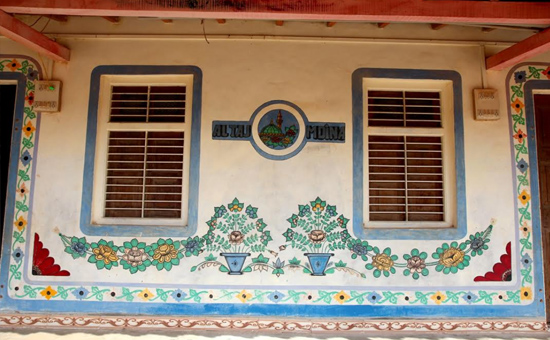 Painting Muslim home, although construction is modern.
Painting Muslim home, although construction is modern.
Going places with Lipan Kaam
The
craftsmen are now teaching students to adapt the design on a piece of plywood.
The
earlier dried camel/donkey dung base is pungent-smelling. The introduction of a
new base material is helping lipan kaam spread across geographies. In fact, the
art now finds a pride of place in modern homes/workspaces in the form of wall
decor.
Author is a Mumbai based artist. All pictures by Sanjeev Nayyar. The
purpose of this compilation is to document and promote. We have given credits
and reference links in this compilation. In case some are missed, it is not
with malafide intent.
Also
see albums
1.
Mud
homes Kutch
2.
Salt Desert
Kutch
3.
Craft
Villages of Kutch
4. Pictures and write up
very good